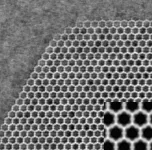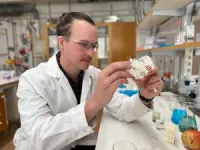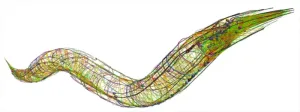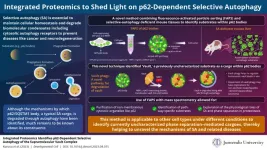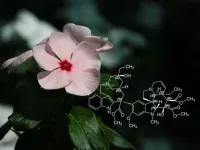(Press-News.org) Researchers from Stockholm University have developed porous crystals made from pomegranate extract to capture and degrade pharmaceutical molecules found in local municipal wastewater. The research is published in the scientific journal Nature Water.
Pharmaceutical compounds affect the human body to improve our health, but they can also have unintentional adverse effects for the wellbeing of wildlife. Hence wastewater treatment plants are facing the challenge of removing emerging organic contaminants (EOCs) such as active pharmaceutical ingredients, and therefore new materials and technologies are required.
One strategy for removing pollutants from water is by using porous materials that behave like sponges. Metal-organic frameworks, so called MOFs, are a type of nanoporous material that are made of metal ions and organic molecules. Most MOFs are made using synthetic organic molecules. But now researchers from the Department of Materials and Environmental Chemistry, Stockholm University, have managed to develop new porous MOFs using a naturally occurring molecule found in plants – ellagic acid.
“Ellagic acid is one of the main building units of naturally occurring polyphenols known as tannins, which are common in fruits, berries, nuts, and tree bark. By combining ellagic acid, which was extracted from either pomegranate peel or tree bark, with zirconium ions, we developed a new highly porous MOF which we named SU-102,” says Erik Svensson Grape, PhD student at the Department of Materials and Environmental Chemistry.
In order to test the performance of SU-102, water that had already been purified at a local wastewater treatment facility was further treated with the new MOF. The results showed that SU-102 removed many of the pharmaceutical pollutants that were not fully removed by the wastewater treatment facility. In addition to capturing the pharmaceutical pollutants, SU-102 was also used to break down pollutants using light in a process known as photodegradation.
“This has been a very exciting project as we got the opportunity to work directly with water samples from the treatment plant, thereby finding an application where our material could be put to use towards a very pressing environmental issue. We hope one day that SU-102 will be used on a bigger scale and also for other environmental applications,” says Erik Svensson Grape at Stockholm University.
END
Porous crystals made from plant extracts purify water from pharmaceutical pollutants
Researchers from Stockholm University have developed porous crystals made from pomegranate extract to capture and degrade pharmaceutical molecules found in local municipal wastewater. The research is published in the scientific journal Nature Water.
2023-05-15
ELSE PRESS RELEASES FROM THIS DATE:
Butterfly tree of life reveals an origin in North America
2023-05-15
About 100 million years ago, a group of trendsetting moths started flying during the day rather than at night, taking advantage of nectar-rich flowers that had co-evolved with bees. This single event led to the evolution of all butterflies.
Scientists have known the precise timing of this event since 2019, when a large-scale analysis of DNA discounted an earlier hypothesis that pressure from bats prompted the evolution of butterflies after the extinction of dinosaurs.
Now, scientists have discovered where the first butterflies originated ...
From molecular to whole-brain scale in a simple animal, study reveals serotonin’s effects
2023-05-15
Because serotonin is one of the primary chemicals the brain uses to influence mood and behavior, it is also the most common target of psychiatric drugs. To improve those drugs and to invent better ones, scientists need to know much more about how the molecule affects brain cells and circuits both in health and amid disease. In a new study, researchers at The Picower Institute for Learning and Memory at MIT working in a simple animal model present a comprehensive accounting of how serotonin affects behavior from the scale of individual molecules all the way to the animal’s whole brain.
“There have been major challenges ...
Assessment of sociodemographics and inflation-related stress
2023-05-15
About The Study: This analysis of U.S. Census Bureau survey data found that rising inflation has become a significant source of stress, especially among women and those who were socioeconomically more vulnerable.
Authors: Cary Wu, Ph.D., of York University in Toronto, is the corresponding author.
To access the embargoed study: Visit our For The Media website at this link https://media.jamanetwork.com/
(doi:10.1001/jamanetworkopen.2023.13431)
Editor’s Note: Please see the article for additional information, including other authors, author contributions and affiliations, ...
Population-based estimates for the prevalence of multiple sclerosis in the US
2023-05-15
About The Study: In this national population-based cohort study of multiple sclerosis (MS) prevalence, researchers found that the distribution of MS in the United States has become more racially and ethnically diverse. White individuals continued to have the highest prevalence of MS followed by Black individuals, individuals from other races, and Hispanic individuals.
Authors: Mitchell T. Wallin, M.D., M.P.H., of the University of Maryland School of Medicine in Washington, D.C., is the corresponding author.
To access the embargoed study: Visit our For The Media website at this link https://media.jamanetwork.com/
(doi:10.1001/jamaneurol.2023.1135)
Editor’s ...
Risk of Parkinson disease among service members at Marine Corps Base Camp Lejeune
2023-05-15
About The Study: This study of 340,000 service members found that the risk of Parkinson disease was 70% higher in veterans who were stationed at Marine Corps Base Camp Lejeune, North Carolina, during 1975-1985 when the water supply was contaminated with the solvent trichloroethylene and other volatile organic compounds. The findings suggest that exposure to trichloroethylene in water may increase the risk of Parkinson disease; millions worldwide have been and continue to be exposed to this ubiquitous environmental contaminant.
Authors: Samuel M. Goldman, ...
New study using novel approach for glioblastoma treatment shows promising results, extending survival
2023-05-15
TORONTO - A new international study published in Nature Medicine and presented as a late-breaking abstract at the American Association of Neurological Surgeons (AANS) annual conference, shows great promise for patients with glioblastoma.
Drs. Farshad Nassiri and Gelareh Zadeh, neurosurgeons at the University Health Network (UHN) in Toronto, published the results of a Phase 1/2 clinical trial investigating the safety and effectiveness of a novel therapy which combines the injection of an oncolytic virus – a virus that targets and kills ...
Finding ‘vault’: Unravelling the mysteries of p62-bodies and the cellular recycling pathway
2023-05-15
Our body functioning is delicately balanced between the synthesis and breakdown of various cellular components. When these cellular components grow old or get damaged, they are digested by a process called “autophagy”—literally, “self-eating.” This process not only helps in the elimination of toxic wastes, but also helps to deliver building blocks for the synthesis of new cellular macromolecules. Thus, autophagy serves as the body's cellular cleaning and recycling system.
Researchers have long been studying the ...
Comprehensive analysis of single plant cells provides new insights into natural product biosynthesis
2023-05-15
Plants are impressive in their diversity, but especially in the variety of metabolites they produce. Many plant natural products are highly complex molecules, such as the alkaloids vincristine and vinblastine, which are produced by the Madagascar periwinkle Catharanthus roseus. These two substances are already indispensable in cancer therapy.
Researchers are very interested in finding out which individual biosynthetic steps are required to form the complex molecules. "Currently, these compounds are still obtained in very small quantities from the plant's leaf extract. We can learn from the plant how this compound is produced and use this knowledge ...
Dementia study reveals how toxic proteins spread through brain
2023-05-15
Fresh insights into the spread of damaging proteins that build up in the brains of people with Alzheimer’s disease could hold the key to stopping the condition progressing, a study says.
Researchers have discovered that synapses, which send essential signals through the brain, are also transporting toxic proteins known as tau around the brain.
Large clumps of the protein tau – called tangles – form in brain cells and are one of the defining features of Alzheimer’s disease. As these tangles spread through the brain during the disease there is a decline in ...
Combined delivery of engineered virus with immunotherapy is safe and improves outcomes in subset of patients with glioblastoma
2023-05-15
HOUSTON ― Intratumoral delivery of an engineered oncolytic virus (DNX-2401) targeting glioblastoma (GBM) cells combined with subsequent immunotherapy was safe and improved survival outcomes in a subset of patients with recurrent GBM, according to results from a multi-institutional Phase I/II clinical trial co-led by researchers at The University of Texas MD Anderson Cancer Center and the University of Toronto.
The study, published today in Nature Medicine, met its primary safety endpoint and demonstrated the combination was well tolerated overall with no dose-limiting toxicities. The study did not meet its primary efficacy endpoint of objective response rate, but ...
LAST 30 PRESS RELEASES:
Patients with clonal hematopoiesis have increased heart disease risk following cancer treatment
Stem cell therapy for stroke shows how cells find their way in the brain
Environment: Up to 4,700 tonnes of litter flows down the Rhine each year
Maternal vaccine receipt and infant hospital and emergency visits for influenza and pertussis
Interim safety of RSVpreF vaccination during pregnancy
Stem cell engineering breakthrough paves way for next-generation living drugs
California grants $7.4 million to advance gene-edited stem cell therapy for Friedreich’s ataxia
Victoria’s Secret grant backs cutting-edge ovarian cancer research
Research paves the way for safer colonoscopy bowel prep for people with compromised gut health
JMIR Publications and Sweden's National Library announce renewal and expansion of flat-fee unlimited open access partnership for 2026
A new 3D-printed solar cell that’s transparent and color-tunable
IV iron is the cost-effective treatment for women with iron deficiency anemia and heavy menstrual bleeding
Doing good pays off: Environmentally and socially responsible companies drive value and market efficiency
City of Hope and Cellares to automate manufacturing of solid tumor CAR T cell therapy
Short-circuiting pancreatic cancer
Groundbreaking mapping: how many ghost particles all the Milky Way’s stars send towards Earth
JBNU researchers propose hierarchical porous copper nanosheet-based triboelectric nanogenerators
A high-protein diet can defeat cholera infection
A more accurate way of calculating the value of a healthy year of life
What causes some people’s gut microbes to produce high alcohol levels?
Global study reveals widespread burning of plastic for heating and cooking
MIT study shows pills that communicate from the stomach could improve medication adherence
Searching for the centromere: diversity in pathways key for cell division
Behind nature’s blueprints
Researchers search for why some people’s gut microbes produce high alcohol levels
Researchers find promising new way to boost the immune response to cancer
Coffee as a staining agent substitute in electron microscopy
Revealing the diversity of olfactory receptors in hagfish and its implications for early vertebrate evolution
Development of an ultrasonic sensor capable of cuffless, non-invasive blood pressure measurement
Longer treatment with medications for opioid use disorder is associated with greater probability of survival
[Press-News.org] Porous crystals made from plant extracts purify water from pharmaceutical pollutantsResearchers from Stockholm University have developed porous crystals made from pomegranate extract to capture and degrade pharmaceutical molecules found in local municipal wastewater. The research is published in the scientific journal Nature Water.
